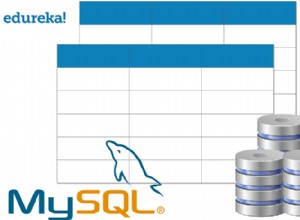En supposant que votre temp1 et temp2 les tables ont les mêmes colonnes, c'est facile à faire lorsque vous utilisez EXECUTE IMMEDIATE , et savoir parcourir les tables système Oracle ALL_TABLES et ALL_TAB_COLUMNS .
Comme je ne sais pas combien de colonnes temp tables ont, l'idée est de comparer (avec votre MINUS d'origine idée) les résultats d'une concaténation des colonnes. Attention, vous ne pouvez pas tout concaténer de la même manière (par exemple, les dates), j'ai donc montré comment vous pouviez obtenir DATA_TYPE .
Une fois que vous avez le résultat ci-dessus, vous pouvez voir manuellement la colonne qui change. Si j'ai le temps, j'ajouterai la partie sur la colonne qui a changé :
- si vous avez un PK, alors nous pourrions l'utiliser pour connaître la ligne qui a changé et boucler à nouveau sur les colonnes ;
- S'il n'y a pas de PK, cela pourrait devenir plus compliqué...
Je m'amuse beaucoup à faire cela, alors je vais essayer de créer un petit code pour cela, en supposant que votre PK est une colonne unique appelée PK :
create or replace procedure compare_tables(t1 in varchar2, t2 in varchar2)
is
v_qry varchar2(10000);
TYPE T_MY_LIST IS TABLE OF VARCHAR2(32000);
v_cols T_MY_LIST; -- list of columns
v_types T_MY_LIST; -- list of columns' type
v_cmp_cols T_MY_LIST; -- list of distinct
v_col_t1_t2 T_MY_LIST; -- t1 minus t2 - value of lines
v_pk_t1_t2 T_MY_LIST; -- associated PKs in t1 minus t2
v_col_t2_t1 T_MY_LIST; -- t2 minus t1 - value of lines
v_pk_t2_t1 T_MY_LIST; -- associated PKs in t2 minus t1
TYPE T_Y_ IS TABLE OF VARCHAR2(32000) index by varchar2(1000);
v_s varchar2(1000); -- for indexing
v_t1_t2 T_Y_; -- list of distinct lines from t1 - t2 /indexed by PK
v_t2_t1 T_Y_; -- list of distinct lines from t2 - t1 /indexed by PK
begin
-- the below assumes all tables have a PK called simply "PK".
v_qry:='PK, ';
execute immediate ' select COLUMN_NAME, DATA_TYPE '
||' from ALL_TAB_COLUMNS where TABLE_NAME=upper('''||t1||''')'
bulk collect into v_cols, v_types;
-- building query with list of columns:
FOR I in 1..v_cols.count loop -- dbms_output.put_line(v_cols(i)||'.'||v_types(i));
v_qry := v_qry||v_cols(i)||'||';
end loop;
v_qry := v_qry||'''''';
execute immediate ' select '||v_qry||' from '||t1||' minus select '||v_qry||' from '||t2
bulk collect into v_pk_t1_t2, v_col_t1_t2;
execute immediate ' select '||v_qry||' from '||t2||' minus select '||v_qry||' from '||t1
bulk collect into v_pk_t2_t1, v_col_t2_t1;
-- build indexed structures that will help compare lines brought by "minus" queries
FOR I in 1..v_pk_t1_t2.count loop
v_t1_t2(v_pk_t1_t2(i)):=v_col_t1_t2(i);
end loop;
FOR I in 1..v_pk_t2_t1.count loop
v_t2_t1(v_pk_t2_t1(i)):=v_col_t2_t1(i);
end loop;
v_s := v_t1_t2.FIRST; -- Get first element of array
WHILE v_s IS NOT NULL LOOP
if (v_t2_t1.exists(v_s)) then
-- distinct rows on same PK
DBMS_Output.PUT_LINE (v_s || ' -> ' || v_t1_t2(v_s));
-- loop on each column joined on PK:
FOR i in 1..v_cols.count
loop
v_qry:= 'select '''||v_cols(i)||':''||'||t1||'.'||v_cols(i)||'||''<>''||'||t2||'.'||v_cols(i)
||' from '||t1||','||t2
||' where '||t1||'.PK='||t2||'.PK'
||' and '||t1||'.PK='||v_s
||' and '||t1||'.'||v_cols(i)||'<>'||t2||'.'||v_cols(i)
;
--DBMS_Output.PUT_LINE (v_qry);
execute immediate v_qry bulk collect into v_cmp_cols;
FOR j in 1..v_cmp_cols.count loop
DBMS_Output.PUT_LINE (v_cmp_cols(j));
end loop;
end loop;
else
DBMS_Output.PUT_LINE (v_s || ' not in ' || t2);
end if;
v_s := v_t1_t2.NEXT(v_s); -- Get next element of array
END LOOP;
v_s := v_t2_t1.FIRST; -- Get first
WHILE v_s IS NOT NULL LOOP
if (not v_t1_t2.exists(v_s)) then
DBMS_Output.PUT_LINE (v_s || ' not in ' || t1);
end if;
v_s := v_t2_t1.NEXT(v_s); -- Get next
END LOOP;
end compare_tables;
/
données de test :
create table temp1 (PK number,
COLUMN1 varchar2(10),
COLUMN2 varchar2(10),
COLUMN3 varchar2(10),
COLUMN4 varchar2(10)
);
create table temp2 (PK number,
COLUMN1 varchar2(10),
COLUMN2 varchar2(10),
COLUMN3 varchar2(10),
COLUMN4 varchar2(10)
);
delete temp1;
insert into temp1
select 1, 'a', 'a', 'bb', 'cc' from dual
union all select 2, 'a', 'a', 'bb', 'cc' from dual
union all select 3, 'a', 'a', 'bb', 'cc' from dual
union all select 4, 'a', 'a', 'bb', 'cc' from dual
;
insert into temp2
select 1, 'a', 'a', 'bb', 'cc' from dual
union all select 2, 'a', 'a', 'b', 'cc' from dual
union all select 3, 'a', 'a', 'bb', 'cc' from dual
;
begin
compare_tables('temp1','temp2');
end;
/
Résultat :
2 -> 2aabbcc
COLUMN3:bb<>b
4 not in temp2
Cela a été inspiré par Rechercher une valeur spécifique dans tous les champs de toutes les tables (Oracle) où la technique de base est expliquée.




